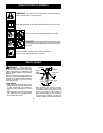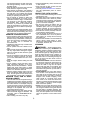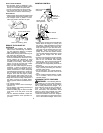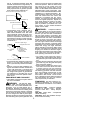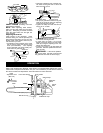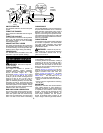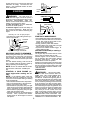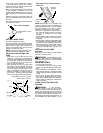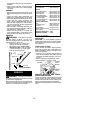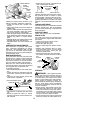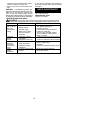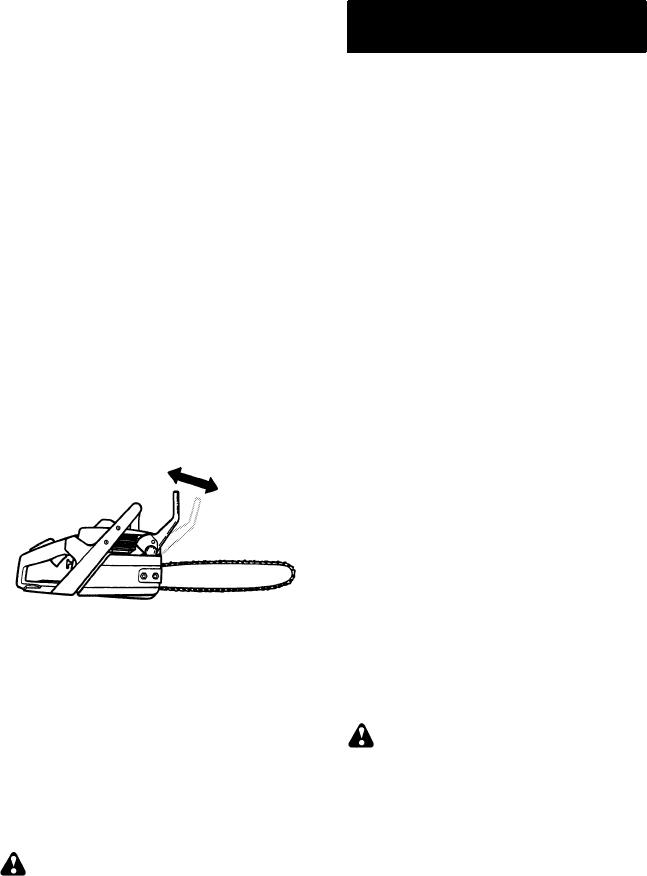
10
duced--kickback guide bars and low--kick-
back saw chains reduce the chance and
magnitude of kickback and are recom-
mended. Yoursawhas alow kickback chain
and bar as original equipment. If the brake
band is worn too thin it may break when the
chain brake istriggered. Witha brokenbrake
band, the chain brake will not stop the chain.
The chain brake should be replaced by an
authorized service dealer if any part is worn
to less than 1/32” thick. Repairs on a chain
brake should be made by an authorized ser-
vicedealer.Takeyourunit to theplace ofpur-
chase if purchased from a servicing dealer,
or to the nearest authorized master service
dealer.
S
This saw is equipped with a chain brake.
The brake is designed to stop the chain if
kickback occurs.
S
The inertia--activated chain brake is
activated if the front hand guard is pushed
forward, either manually (by hand) or
automatically (by sudden movement).
S
If the brake is already activated, it is
disengaged bypulling thefront handguard
back toward the front handle as far as
possible.
S
When cutting with the saw,the chain brake
must be disengaged.
Disengaged
Engaged
Braking function control
CAUTION:
The chain brake must be
checked several times daily. The engine
must berunning when performing thisproce-
dure. This is the only instance when the saw
should be placed on the ground with the en-
gine running.
Place the saw on firm ground. Hold t he han-
dles with both hands and apply full throttle.
Activate the chain brake by turning your left
wrist against the hand guard without releas-
ing your grip around the front handle. The
chain should stop immediately.
Inertia activating function control
WARNING:
When performing the
following procedure, the engine must be
turned off.
Hold the chain saw approximately 14” (35
cm)above a stump orother wooden surface.
Release your grip on the front handle and
use the weight of the saw to let the top of the
guide barfall forward and contact the stump.
When the tip of the bar hits the stump, the
brake should activate.
CUTTING METHODS
IMPORTANT POINTS
S
Check chain tension before first use and
after 1 minute of operation. S ee CHAIN
TENSION in the ASSEMBLY s ection.
S
Cut wood only. Do not cut metal, plastics,
masonry, non-wood building materials,
etc.
S
Stop the saw if the c hain strikes a foreign
object. Inspect the saw and repair or r e-
place parts as necessary.
S
Keep thechain outofdirt andsand. Evena
small amount ofdirt will quickly dull achain
and thus increase the possibility of kick-
back.
S
Practice cutting afew small logs using the
following techniques to get the “feel” of us-
ing your saw before you begin a major
sawing operation.
S
Squeeze the t hrottle trigger and al-
low the engine to reach full speed
before cutting.
S
Begin cutting with the saw frame
against the log.
S
Keep the engine at full speed the en-
tire time you are cutting.
S
Allow the chain to cut for you. Exert
only light downward pressure. If you
force the cut, damage to the bar,
chain, or engine can result.
S
Release the throttle trigger as soon
as t he cut is completed, allowing the
engine to idle. If you run the saw at
full throttle without a cutting load, un-
necessary wear c an occur to the
chain, bar, and engine.
S
To avoid losing control when cut is
complete, do not put pressure on
saw at end of cut.
S
Stop the engine before setting the saw
down after cutting.
TREE FELLING TECHNIQUES
WARNING:
Check for broken or
dead branches which can fall while cutting
causing serious injury. Donot cutnear build-
ings or electrical wires ifyou donot knowthe
direction of tree fall, norcutat night since you
will not be ale to see well, nor during bad
weather suchas rain, snow ,or strong winds,
etc.
S
Carefully planyoursawingoperation inad-
vance.
S
Clearthe workarea. You needa cleararea
all around the tree so youcan have secure
footing.
S
Study the nat ur al condi tions t hat can cause
the tr ee t o fall in a particular direction.
Natural conditions that can cause a tree to
fall in a particular direction include:
S
The wind direction and speed.
S
The lean of the tree. The lean of a tree
might not be apparent due to uneven or
sloping terrain. Usea plumb orlevel tode-
termine the direction of tree lean.
S
Weight and branches on one side.
S
Surrounding trees and obstacles.



